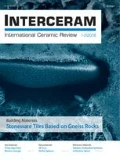Refractorius? So could have been the name of a — fictitious — gladiator in ancient Rome! According to the Latin meaning: Strong and indestructible, robust and durable — even under the most extreme conditions. He resists the hardest demands, withstands temperatures as they prevail in “hell”, and sometimes shows a stubborn and unruly nature. Refractorius is hero and a rebel at the same time.
There is no doubt that this is also true for refractory materials. They can also be seen to some extent as the “heroes” among the materials. Refractories are designed for applications under extreme conditions. They must withstand exceptionally high temperatures of 1,500 °C and more under high load. These materials are characterized by their high melting and softening points and their resistance to high temperature changes, chemical attack and wear. Refractories are undergoing high physical and chemical changes and come into contact with aggressive media.
Humanity has used refractories for thousands of years. Especially the energy-intensive key industries in the fields of iron and steel, glass and ceramics, environment and power plant construction, petrochemicals and chemicals are dependent on these materials. With a market share of around 70%, the iron and steel industry in particular is one of the biggest beneficiaries of refractories. Another important driver is the construction sector.
So the prospects are good, because refractories are regarded as enablers of high-temperature technologies. In recent years, the refractories industry has initiated many research and development projects, ranging from raw materials and highly versatile products to plant engineering and system solutions for the industry. How multifaceted this material is, what opportunities and challenges there are for the industry, we will be able to see again this year at the 61st International Colloquium on Refractories in Aachen, Germany. On October 26 and 27, representatives from science and industry will once again have the opportunity for professional and personal exchange in a highly innovative and inspiring environment. In addition to the specialist lectures, the programme will also include a poster show and an accompanying specialist exhibition. And of course, the Gustav Eirich Award once again presented to young scientists for their projects and ideas.
Our magazines “Interceram” with the special edition “Refractories Manual” and the “Keramische Zeitschrift” (in German) are media partners of this traditional event. Since the beginning of the year, these journals have been published under the umbrella of Springer Fachmedien Wiesbaden GmbH, Germany. As a result, this has considerably increased our options in the classic print and digital sector — a tremendous advantage for our readers and business partners. Springer Nature and https://doi.org/www.springerprofessional.com provide access to an internationally recognized knowledge database. Subscribe to our newsletter or just drop by our stand!
Author information
Authors and Affiliations
Corresponding author
Rights and permissions
About this article
Cite this article
Sanders, W. Refractories — Heroes among Materials. Interceram. - Int. Ceram. Rev. 67 (Suppl 1), 3 (2018). https://doi.org/10.1007/s42411-018-0049-5
Published:
Issue Date:
DOI: https://doi.org/10.1007/s42411-018-0049-5

